The jade shroud reflects the funeral jade culture in ancient Chinese burial practice, and Han dynasty is the prime in the development of the Chinese jade culture. The funeral jade, literally, is made for the purpose of burial, evolved from remote antiquity, even dates back to Liangzhu Culture period, as some scholar believed[1]. Many grand tombs in the Liangzhu culture period have yielded quite a lot jade artifacts, and the corpse were fully covered by the jade objects. In Longshan culture period, jade plug began to be carved specifically for being placed into the mouth of the deceased, and this practice was carried on in Shang dynasty. With the improvement of the funeral rituals in Zhou dynasty, a set of special funeral jade objects used for the deceased in the funeral process was invented accordingly, such as the jade articles for decorating coffin, covering the face, plugging into the mouth, grasping in the hands of the deceased, covering the toes, and offering ceremony, as well as the burial Bi.
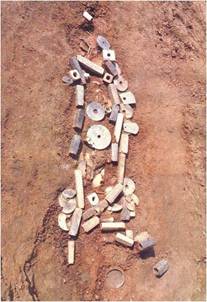
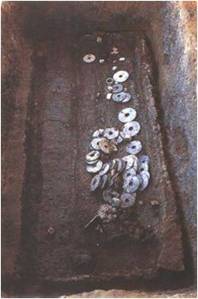
Left: The jade artifacts uncovered in No.3 tomb at Sidun, Wujin,Changzhou city, Jiangsu province
Right: The jade artifacts unearthed from the Fanshan M23 tomb, Hangzhou city
Of the burial jade objects, the face covering and the jade articles sewn on the clothes were viewed as the precursor of the subsequent jade shroud throughout the entire Han dynasties. Face covering came into being during the reign of King Gong of the Western Zhou dynasty, the sample unearthed from M157 tomb at Zhangjiapo, in Fengxi is the earliest known so far. In the mid-late Western Zhou dynasty, the face covering witnessed a prosperous time, and more intricate, more excellent samples have been successively found in the tombs of Jing Shu, the prominent court official of Zhou court, tombs of the rulers of the principalities, such as the tombs of Duke Jin, and royal cemetery of the Guo state in Sanmenxia city, and so on. Some evidence indicate that jade shrouds may have been employed in the high-level tombs of the late Spring and Autumn period, and face coverings were replaced by the helmet. The jade suit of Han dynasty just followed the tradition.
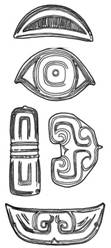
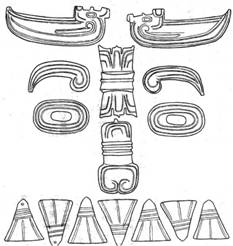
Left: Jade Mask uncovered from M157, M303 tomb at Zhangjiapo of Fengxi County, Shaanxi
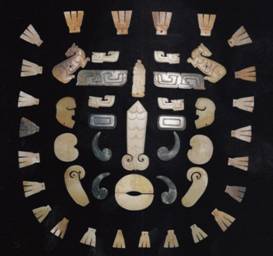
Right: Jade mask from M62 tomb of Duke Jin in Shanxi
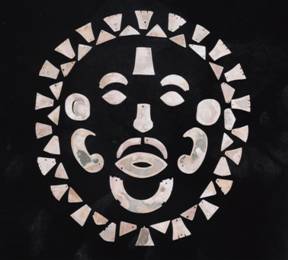
Jade mask unearthed from the cemetery of the Guo principality in Sanmenxia city, Henan
The introduction of the jade suit sewn with gold thread explicitly reflected the social hierarchy of the ages, and it is one of the indications of the institutionalized social hierarchy in the period. As the mortuary clothes wore exclusively by the Han emperors and nobilities, the jade suit was called as “jade casket”, “ jade cage” in Han texts, and it was distinctively regulated on the basis of different ranks. A chapter “Etiquette” in The Book of Later Han stated that the Emperors should be armoured by the jade suit sewn with gold thread after death; the feudal lords, Liehou(Marquis of the Imperial Domain), the emperor’s consorts, and princesses, had the jade suit sown with silver thread; emperor’s sisters and other relevant people, had the jade suit sewn with copper wire.
However, the rules were not so strictly followed in Western Han dynasty, and they were greatly improved in the Eastern Han dynasty over a long time. So far, no jade shroud sewn with gold wire have been archaeologically found from the tombs of the feudal lords, or Liehou, and officials of the identical rank of the Eastern Han dynasty; the jade suits uncovered from the officials of the feudal loads class were sewn with silver thread; while all the jade shrouds in the tombs of the Liehou and its peers with the same rank, sewn with copper wire in that period. In the late Eastern Han dynasty, the power of the imperial court waned due to the collapse and the breaching of the ritual and propriety, some lesser nobilities began to adopt jade shroud in their funeral practice.
Statistics suggest that as many as 81 tombs have been found with jade suits and jade coverings in total. In Sep. 1946, quite a lot jade tablets were discovered in a Han tomb at Langcun village of Handan city, Hebei province, the tomb occupant was recognized as Marquis Xiangshi, Liu Anyi of the Western Han dynasty, and it was confirmed to be the earliest Han tomb being found with jade suit in China. Followed the founding of the P.R. China, several Han tombs were found with scattered jade plaques for jade suit, whereas, these tombs had ever been raided, the original information of the jade suit cannot be acquired. In 1968, with the excavation of the mausoleum of Prince Zhongshan, Liu Sheng, of the Western Han dynasty, in Mancheng city, Hebei province, two sets of intact jade suits sewn with gold thread were brought to light, and the features and formation of the genuine jade suit were exposed to the world.
While the jade suit of Liu Sheng was found, it was wore on the corpse, and divided into five parts: the helmet, the jacket, the trousers, the shoes, and the gloves, as well as the Huang-like (semicircular) jade articles in hands and the gilt bronze headrest inlaid with jade as the accessories. With an overall length of 188cm, the jade suit consists of 2498 jade plaques, the sewing gold wire weighs some 700g.
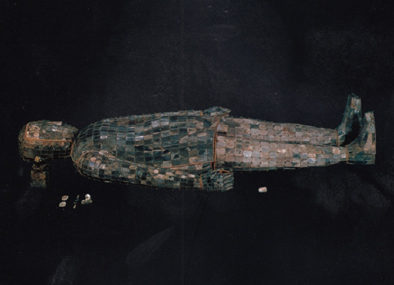
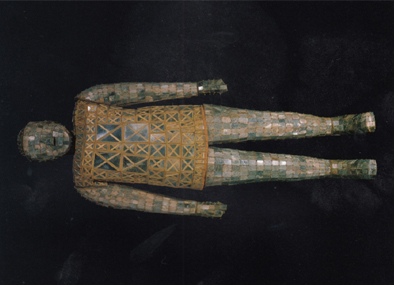
In 1978, a set of jade suit with just head covering, gloves, and shoes sewn with gold wire was found from the tomb of Liu Ci of the early Western Han dynasty in Linyi county, Shandong province, though it was called as Jade Armor Sewn with Gold Thread in the brief archaeological report, it may have been an interim in the course of the evolvement of the jade shroud, a piece of unfinished object. [5]
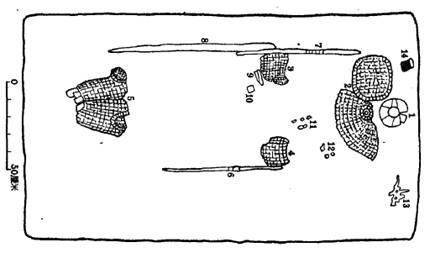
Drawing of the position of the Jade Armor Sewn with Gold Thread in the tomb of Liu Ci
In 1983, a jade shroud sewn with silk thread was discovered from the mausoleum of the King Nanyue at Xianggang, Guangzhou city, with the tomb occupant was confirmed to be the second king of Nanyue principality, Zhao Mo. After restoring, the jade shroud had an overall length of 173cm, composed of 2291 jade plaques totally. Situated at the South China, far from the Central Plains, Nanyue kingdom had distinctive economic and cultural features from that of the Central Plains, thus the hierarchy over the jade burial suit was defective. Though being a roughly contemporary with Liu Sheng, King Jing of Zhongshan state, Zhao Mo had a much crudely made burial jade suit in his tomb, a special case in the practice of jade burial suit of the mid-Western Han Dynasty.
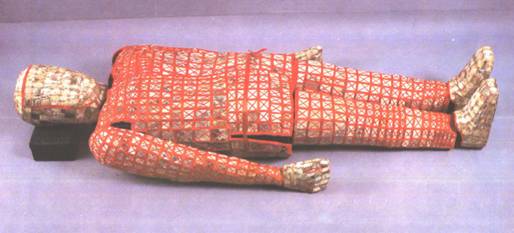
The jade suit sewn with silk thread in the mausoleum of King of Nanyue in Guangzhou.
In Wei and Jin period, national economy was shattered due to the frequent wars, the ideas of opposing extravagance, appreciating frugality and considering the social reality in the burial began to prevailed. Additionally, Cao Cao and his son, Cao Pi, were the pioneer of the practice. Emperor Weiwen of Wei, Cao Pi, prohibited the jade suit in the funeral activities not only for encouraging the frugal burial, opposing wasting, but also for the consideration of the rampant tomb robberies. Apparently, the treasures in the tombs stimulated the tomb robbers’ motivation. In the hope of protecting their corpse from decaying by the jade articles, the tomb owner, had their afterlife dreams smashed, ended up with skeleton missing.
From the Western Zhou throughout the Eastern Han dynasties, jade burial objects witnessed the prime in the Chinese history. In addition to being the sign for the wealth and the station in social hierarchy, what are the other reasons do you think to make people of the ages so enthusiastic for interring the jade articles in the tombs? And could the burial jade objects and jade suit really protect the corpse from decaying?
Your answer please, if you have any questions or answer, please feel free to send us email, we are waiting for your answers and participation, and your comments, answers and suggestions will be highly appreciated. We will select and publicize the most appropriate answers and comments some time in the future.
Weekly Selection Email: meizhouyipin@chnmus.net
Liang Fiefdom and its cemetery
In 168 B.C, Emperor Wen of Han granted his second son and younger brother of Emperor Jing of Han, Liu Wu, Prince Huaiyang, the title “King Liang”. Liang fiefdom was abolished in 9 C.E. when Wang Mang usurped the throne.
The Liang royal cemetery, formed since Liu Wu was buried in the Mangdang mountains, ware over 30 Kilometers northeast Yongcheng city, Henan province. Mangdang mountains, a range of gently rolling rocky hills, consist of over 10 small hilltops, with the main peak of Mangdangshan 156.8 meters above the sea level. In 144 B.C, Prince Liangxiao, Liu Wu, died of illness, and was originally buried at Mt. Mangdang, Yongcheng, and followed by the succeeding eight inherited Kings of Liang of seven generations of Liang fiefdom, thus formed the concentrated royal family cemetery of Liang state, which were scattered in the eight hilltops: Bao’anshan, Lishantou, Fuzishan, Tiejiaoshan, Nanshan, Xishan, and JIaoshan, and the graves fell into two types: large-scale cliff cave and vertical rock pit. Of the tombs, the occupants of No. 1 and No.2 in Bao’anshan were confirmed respectively to be the prestigious King Liangxiao, Liu Wu, who was meritorious for cracking down the Rebellion by the Seven Princes, and his wife. Unfortunately, both the two tombs had been robbed in the past.
Bibliography:
[1] Wang Zunguo, Summary on funeral jade objects of Liangzhu Culture[J]. Cultural Relics Journal, 1984(2).
[2] [4] Sun Qingwei, Study on the Rules of Jade in Zhou dynasty. Shanghai Classics Publishing House, 2008.
[3]Lu Zhaoyin. On the Jade Shroud of the Han Dynasty[J].Archaeology Journal, 1981(1).
[5]Wang Jing: Study on Jade Suit of Han Dynasty. A dissertation for Master degree of Hebei Normal University 2008.
Lying at the Eastern end of the hilltop of the Mt. Xishan, Mangdang mountains, Yongcheng city, Henan province, No.1 Xishan tomb, though was disturbed in the past, still yielded a great amount of jade plaques, and they were confirmed to be the jade shroud of a King of Liang State in the late Western Han dynasty.
The jade shroud sewn with gold thread consists of five parts: helmet, jacket, trousers, gloves, and shoes, the sleeves, and the shoes. The helmet comprises the mask and the hood, with a protruding knot outlining the nose. The jacket consists of the front panel, the back panel, the left and right sleeves. The trousers, sleeves, and the shoes are divided into two pieces in left and right respectively. The gloves are in bending positions, and the shoes are square in the toe part with a high-waist in the middle. The whole suit are made up with 2008 small plaques sewn together with gold wire. In Han dynasty, some other jade articles, which usually constitute the whole shroud, were shaped to cover the eyes of the dead, and plugs to fit the ears and nose. Consequently, jade pigs in hands, jade cicada, earplug, nose plug and etc., are also the accessories attached to the entire jade suit.
A great majority of the jade plaques are grey green, few are grey brown, or bear black dots, as a result of erosion in ooze. Most of the jade plaques were polished on both sides, others just the front side while the sliced marks remained on the back. And most of the surfaces are plain, but some jade plaques were transformed from other jade articles, therefore, the previous motifs still remained. The plaques are quite different in form, size, and measurement.
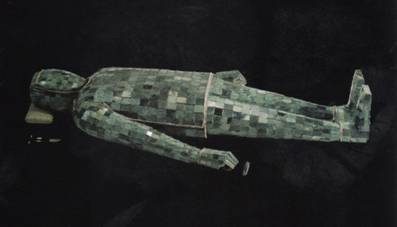
Title: Jade Shroud Sewn with Gold Thread, comprising 2008 pieces of jade plaques after being restored.
Medium: Jade
Period: Han dynasty
Provenance: unearthed from No.1 Han tomb pit, at Xishan, Yongcheng, Shangqiu city, Henan province in 1985.

Cao Fangfang: born in Zhongmu county, Zhengzhou city. A graduate student enrolled in 2011, specialised in study on Shang and Zhou dynasties, with Professor Sun Qingwei as her Tutor. Her dissertation covers jade study.